The Snapdragon 855 Performance Preview: Setting the Stage for Flagship Android 2019
by Andrei Frumusanu on January 15, 2019 8:00 AM EST- Posted in
- Mobile
- Qualcomm
- Smartphones
- SoCs
- 7nm
- Snapdragon 855
System Performance - Slightly Underwhelming?
While synthetic steady state workloads are one thing, real-world workloads are more transactional and their performance is determined not just by hardware, but as well by software. Here things like the CPU scheduler and OS APIs can have a big effect on the resulting perceived performance of a device.
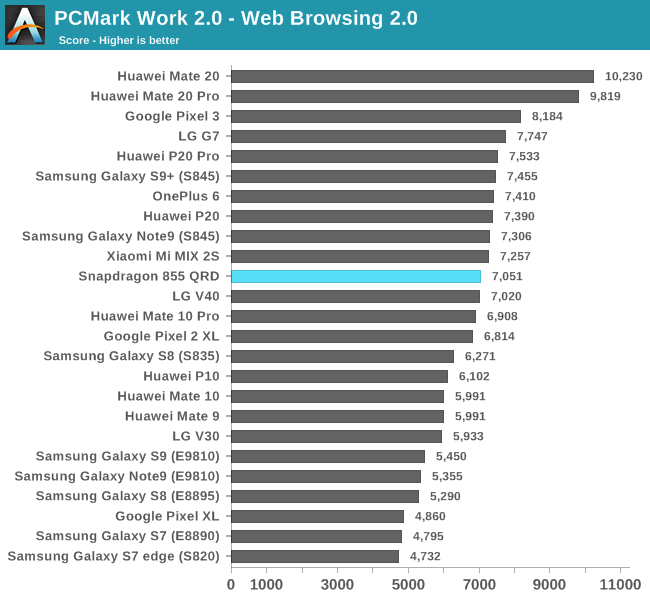
Starting off with PCMark’s Web Browsing 2.0 test, the Snapdragon 855 goes off to a bad start. Here for some reason the S855 QRD wasn’t able to distinguish itself from the lower end of Snapdragon 845 devices – here we had expected the phone to perform and compete similarly to the Kirin 980 in the Mate 20’s.
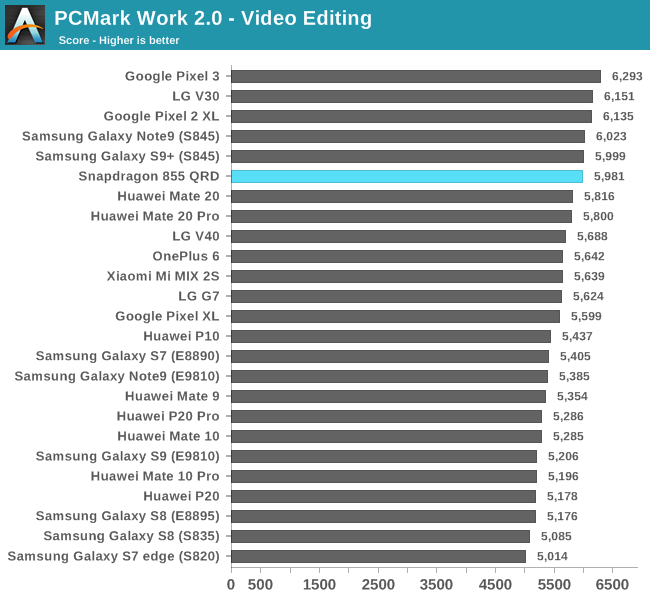
The video editing score is again also quite mediocre, but again the reason for this is that this test has largely reached a performance plateau where most of today’s devices no longer really showcase meaningful differences between each other.
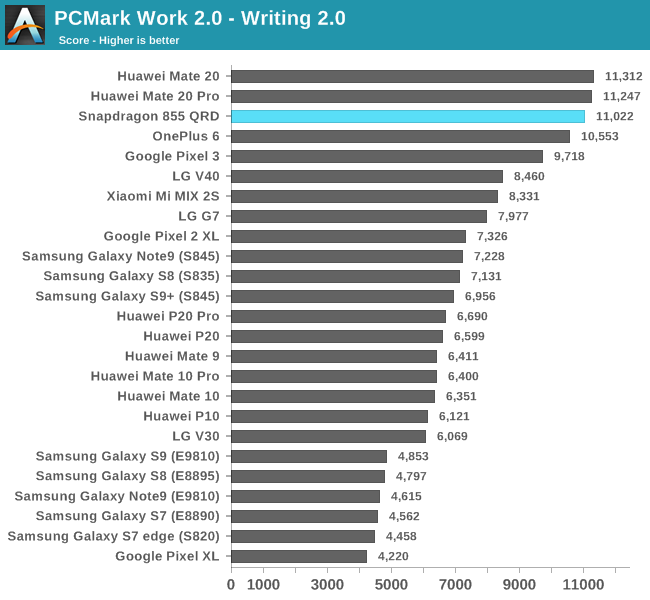
The writing sub-test is among one of the most important in PCMark, and luckily here the Snapdragon 855 QRD performed as expected as it’s within range of the Mate 20’s.
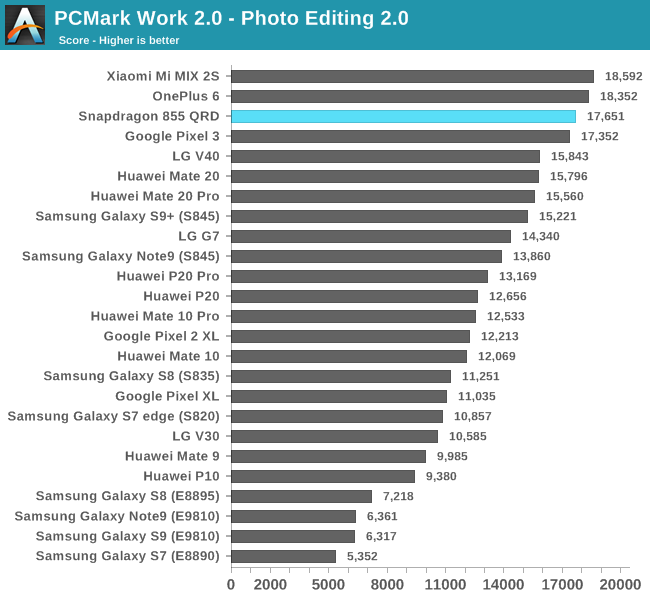
The photo editing sub-test is characterised by shorter heavy RenderScript workload bursts. The QRD performs well, although it’s within the results of the top Snapdragon 845 devices.

Finally in the data manipulation result which is more single-thread bound, we see the Snapdragon 855 perform well, but still remains neck-and-neck with the Kirin 980 devices as well as behind the Pixel 3’s very aggressive scheduler implementation.

Overall, the Snapdragon 855 QRD in PCMark ended up among the top scorers, however I found the result to be a bit disappointing as it doesn’t appear to achieve a higher ranking than the Pixel 3, and Huawei’s Kirin 980 Mate 20’s are also ahead.
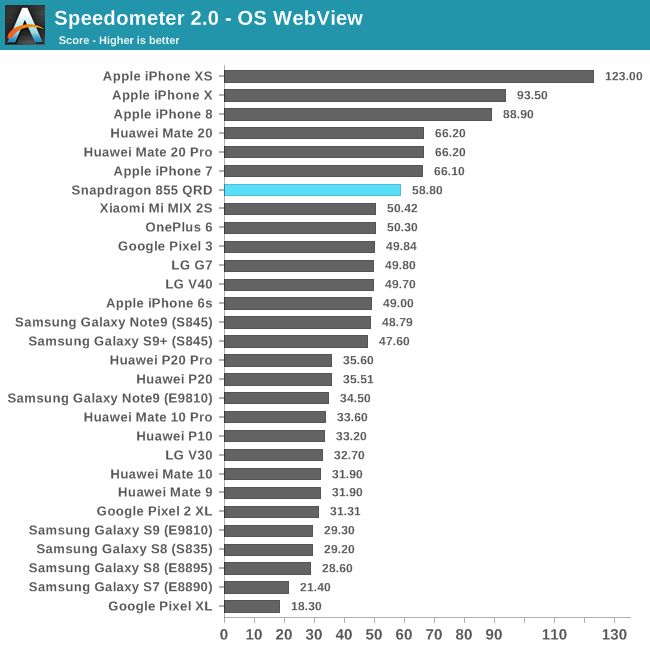
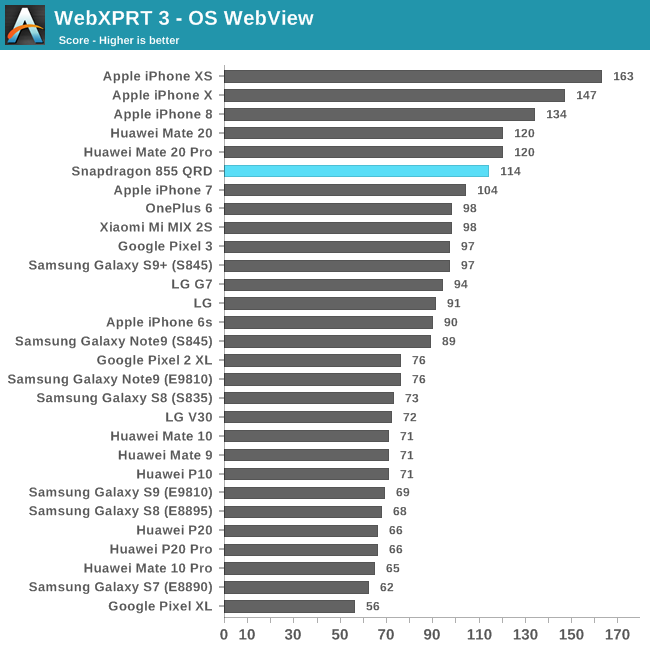
I’ve discussed the results with Qualcomm, and they were surprised to see the numbers end up like this. They stated that it’s something they will look into, and stated that it’s possible that the scheduler and software stack on commercial devices might improve performance. Something to be revisited once we get our hands on the first phones.
The web-based benchmarks such as Speedometer 2.0 and WebXPRT 3 showcase similar relatively muted results. Here I had expected Qualcomm to perform really well given the scheduler performance showcase of the Snapdragon 845. The results of the Snapdragon 855 are quite meagre, especially in a steady-state throughput workload such as Speedometer 2.0. Here the Snapdragon 855 only manages to showcase a ~17% improvement over the last generation, and also lags behind the Kirin 980 by some notable amount.
Performance Scaling Ramp Test
One of the newer kind of tests I introduced last year and has used in our review of the Apple iPhone XS is the scaling ramp test – here showcasing the improved DVFS responsivity of iOS12 across several generations of iPhones.
I’ve quickly ran this on the S855 QRD to be able to get a sense of the scheduler and DVFS mechanism:
Here we see the Snapdragon 855 QRD being able to scale from a sleeping idle workload state to its maximum performance state in around 100ms. To compare this, I also showcase the scaling behaviour of the S845 in both the S9+ as well as the Pixel 3. The difference between the Pixel 3’s aggressive boost behaviour and the S9’s more step-wise frequency scaling showcases the best visual representation of the perceived responsiveness difference between the two devices.
The Snapdragon 855 here falls somewhere in-between both. It’s to be noted that the workload does get boosted to an “efficient” big core at 2.45GHz in around 40ms which is a very fast scaling behaviour.
Comparing the Snapdragon 855 against the Kirin 980, we see that the Snapdragon isn’t any slower in reaching the maximum performance states. What is odd in these results is that the workload sees a significant pause of ~2.4ms when migrating over from the little cores, something that seems to affect only devices with Qualcomm’s custom scheduler. It’s an interesting find that I’ll have to investigate more.
Overall, real-world performance of the Snapdragon 855 is a bit lower than I had expected it to be. I’m not exactly sure what the cause here is; on the scheduler side we’ve verified that the workload doesn’t inherently scale slower than the Kirin 980. The only other explanation I could see is that we might be seeing some disadvantage of the smaller L3 cache or even the higher DRAM latency.
As we’ve seen in past Snapdragon performance previews, final commercial device performance is subject to change, and it’s possible the performance situation will be more tuned in actual shipping phones.


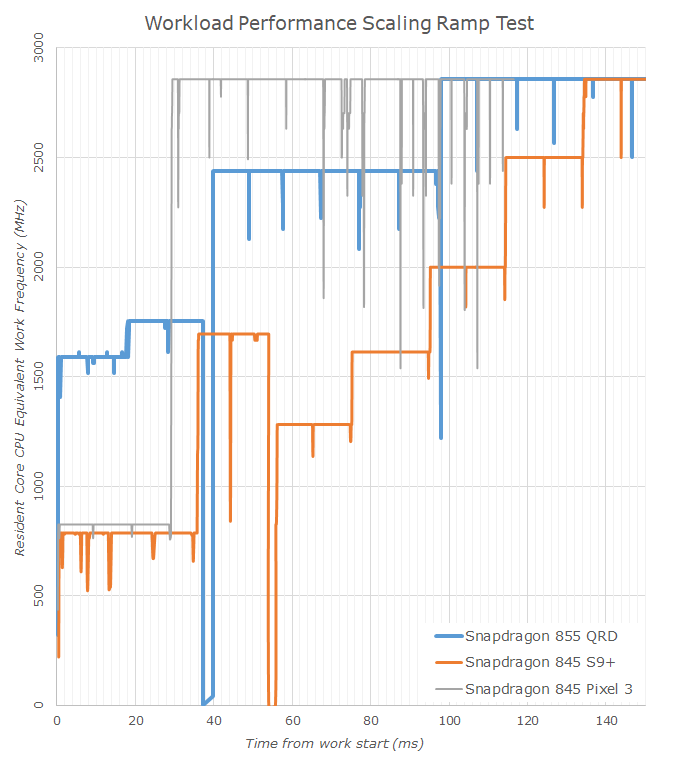
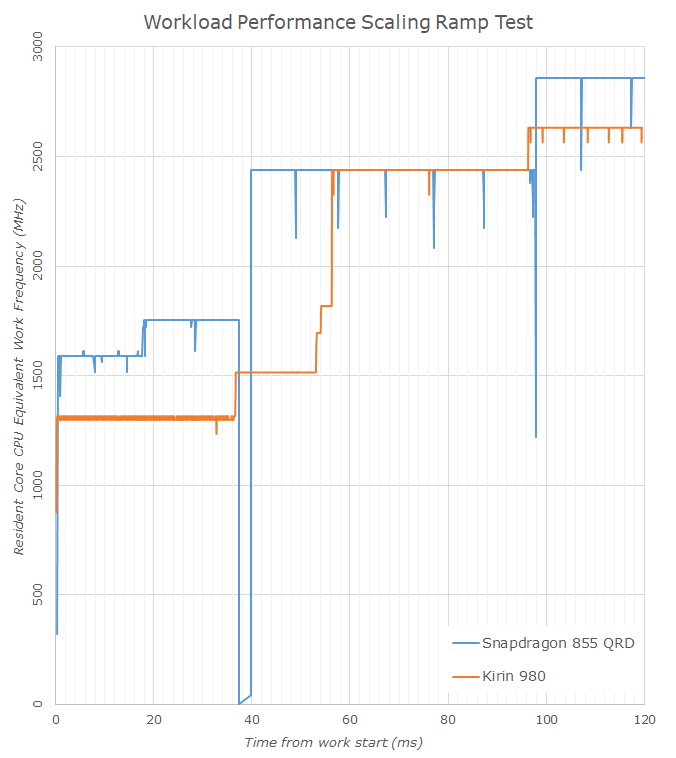








132 Comments
View All Comments
goatfajitas - Tuesday, January 15, 2019 - link
What makes the Ax series so fast is the tight OS integration. It's a good chip, but not years ahead hardware-wise. What makes the whole thing so fast is the OS and how it's implemented. Either way good for Apple, but it's more SW than HWbji - Tuesday, January 15, 2019 - link
You tried to make this point before and failed. Give it up maybe?goatfajitas - Tuesday, January 15, 2019 - link
You may have failed to grasp it, but that is on you.Graag - Tuesday, January 15, 2019 - link
No, it's just blatantly wrong.tuxRoller - Wednesday, January 16, 2019 - link
Proof?sean8102 - Wednesday, January 16, 2019 - link
I don't buy that either. It's pretty well known Apple has some damn good chip designers in house. I'm no expert but one of the biggest things that stand out to me when comparing Apples designs is how much cache they use. The A12 has 128KB instruction and 128 KB data L1 cache and 8MB of L2 cache. It seems the 855 has basically ~2MB L2 cache (divided among each "cluster") and 2 MB of L3 cache. I haven't seen a Android avalible SOC that comes close the amount of cache that Apple puts on its SOC's which from what I understand is quite expensive to do, and results in a larger die size. But give large performance benefits. Of course that's only one example of something they do differently, considering that with a 2 high power plus 4 low power cores setup they are still so far ahead they must be making significant changes compared to the reference design they get from ARM.Their hardware team deserves serious credit for staying so far ahead for so long.
HStewart - Tuesday, January 15, 2019 - link
One big question I have always had with ARM based device especially in performance. - How does it compared with x86 platform except for power. This can be difficult to actually truly represent - especially with design difference in OS and applications.Application why a good example is running AutoCad - can even latest iPad Pro truly have performance of say latest quad or six core x86 based CPU and high end mobile GPU. I know Apple has iPad Pro version of Photoshop - but this is based on Photoshop CS and I personally like the earlier series - which I own CS 5.0
I think on ARM we long way from having a full version of Autocad, Solidworks, Lightwave 3d, 3dmax and others high end professional applications.
cpkennit83 - Tuesday, January 15, 2019 - link
A12/A12X devices compare very favorably with U series Intel chips, and smack Y series chips. Lack of software is not due to lack of power, but perceived demand.goatfajitas - Tuesday, January 15, 2019 - link
"A12/A12X devices compare very favorably with U series Intel chips" on selective tasks. It's a long way off from it in raw power.Wilco1 - Tuesday, January 15, 2019 - link
Benchmarks clearly show performance is about the same. In fact it looks like A12X is well ahead in terms of raw power, for example by 30% on compilation (LLVM test).